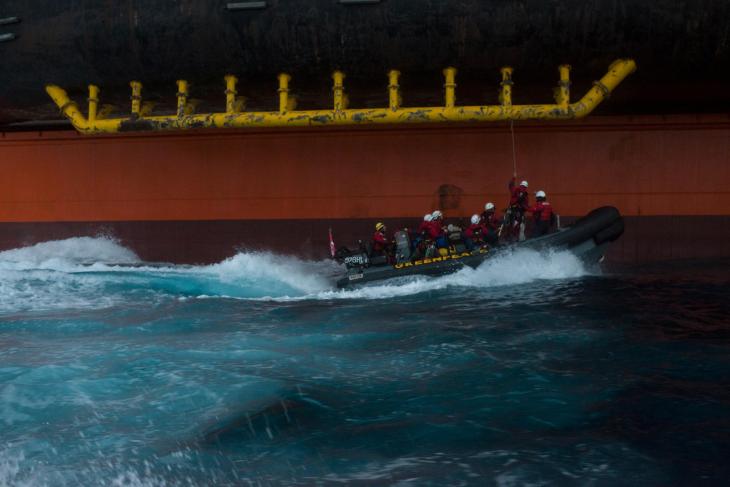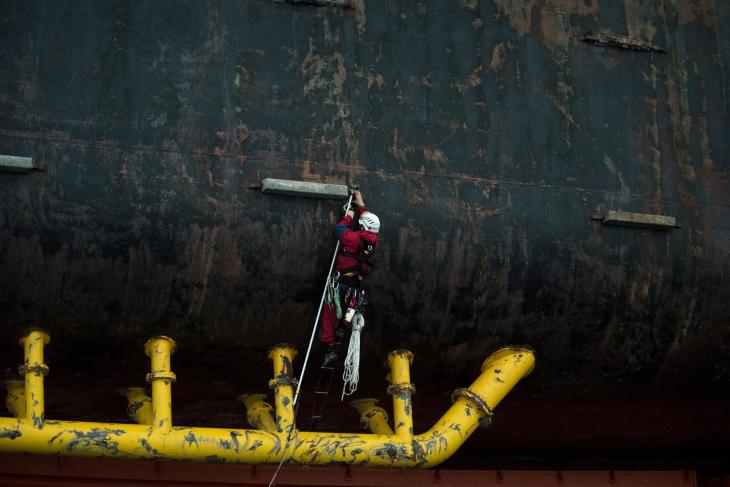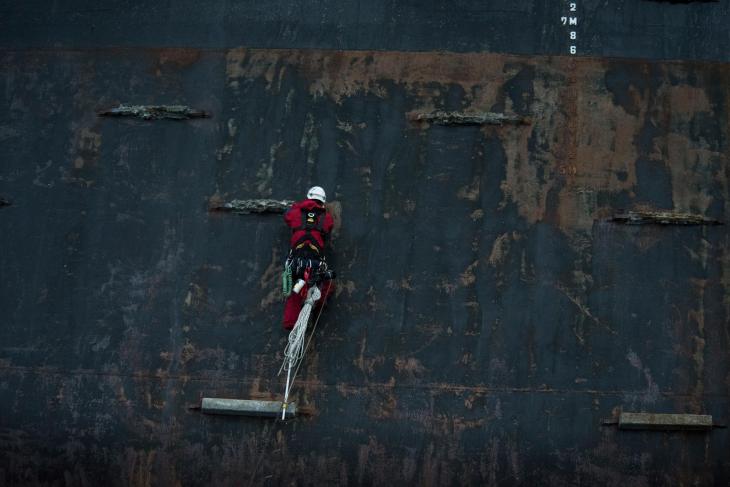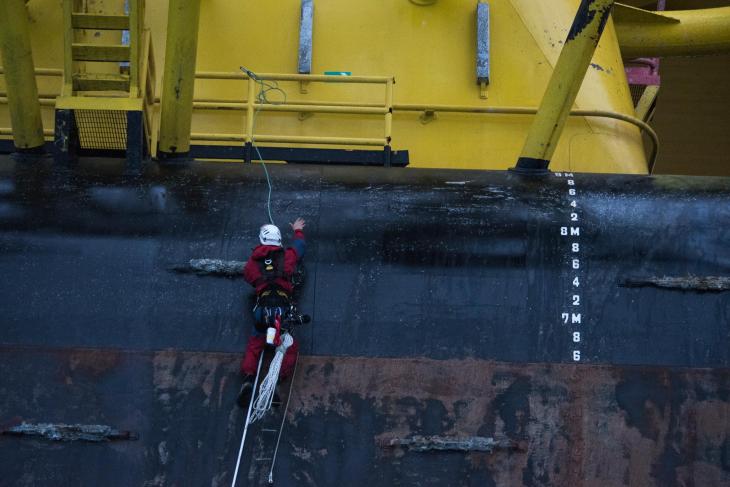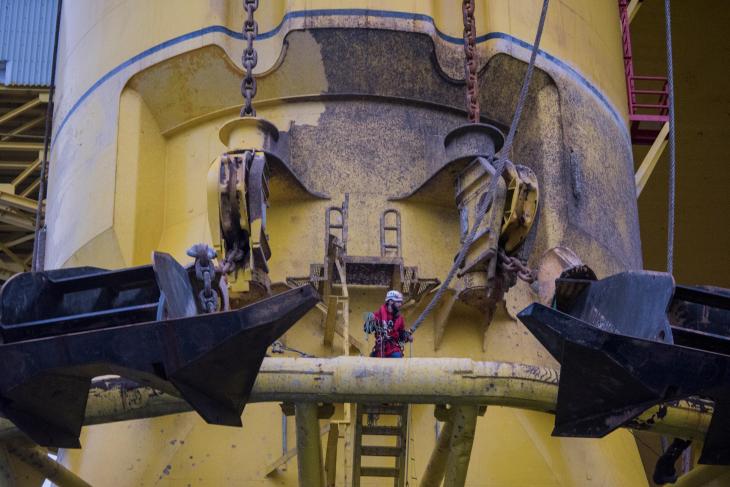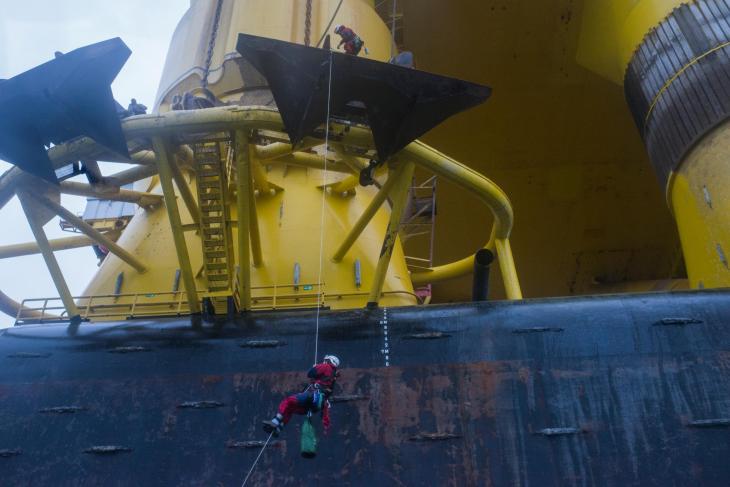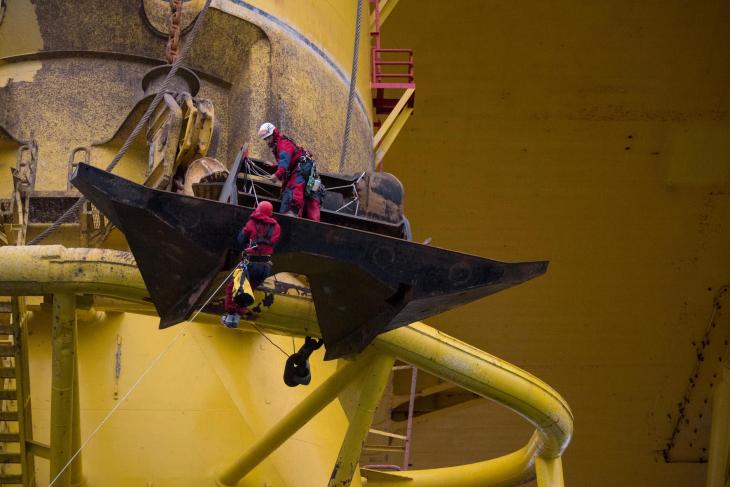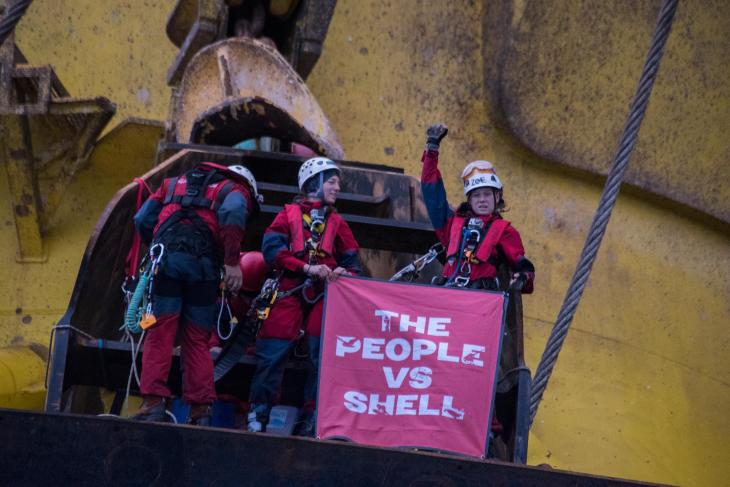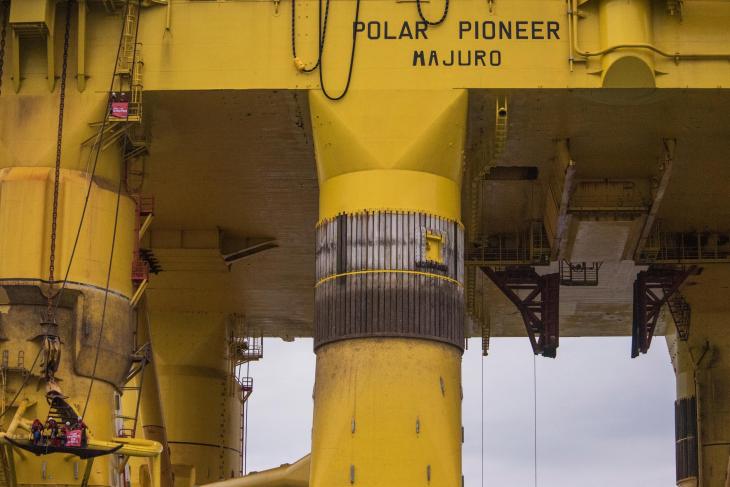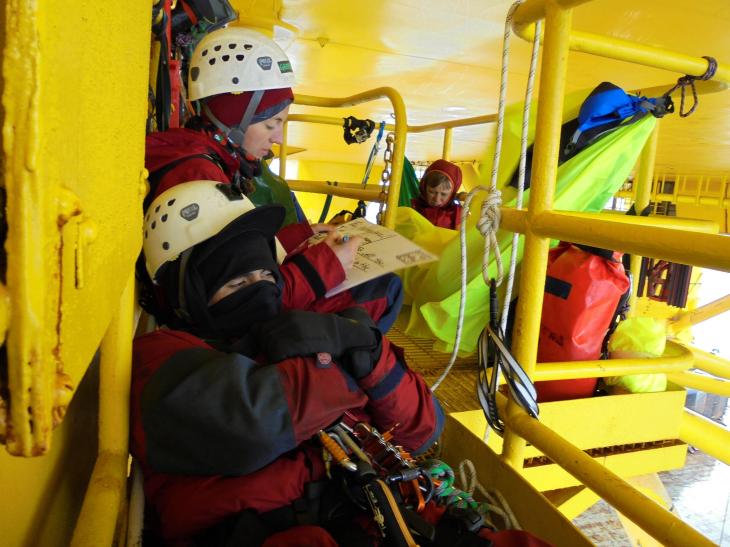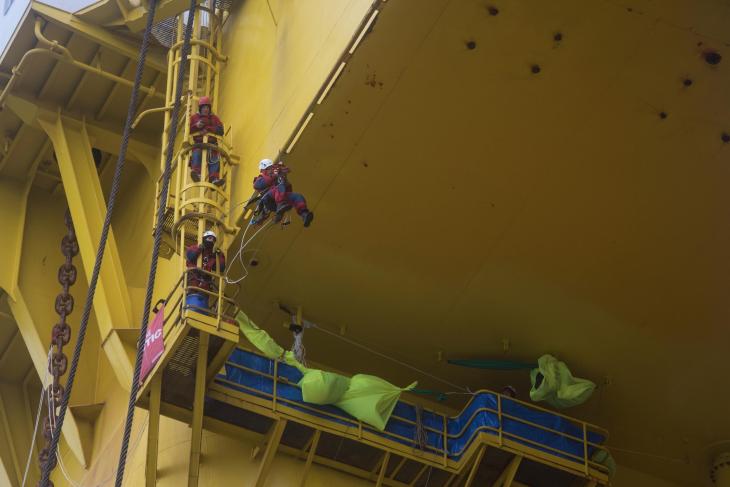Climbing, ropes, and rigging can be used to draw attention to an issue, communicate a message, and/or directly interfere or stop an activity from happening — events often referred to as actions. All climb actions will fall under one or more of the following categories.

Photo-ops: Used to boldly articulate a demand, to rebrand a target, or to provide a message frame or larger-than-life caption for an action. Photo ops are reliant on third party media to carry and spread a message/image.
 Direct communications: Speak directly to the target. They take place at the location of a target audience (CEO, shareholders, etc.) and are not reliant on media.
Direct communications: Speak directly to the target. They take place at the location of a target audience (CEO, shareholders, etc.) and are not reliant on media.
 Occupations: Used to hold space, to pressure a target, to reclaim property, or to defend against development. Occupations at height can take a myriad of forms and are often used to heighten a message or to stop something directly.
Occupations: Used to hold space, to pressure a target, to reclaim property, or to defend against development. Occupations at height can take a myriad of forms and are often used to heighten a message or to stop something directly.
 Blockades: Used to physically shut down something, to protect something, or to make a symbolic statement. Aerial blockades can be used as a form of direct action or as a means to support another activity.
Blockades: Used to physically shut down something, to protect something, or to make a symbolic statement. Aerial blockades can be used as a form of direct action or as a means to support another activity.
Tools and Tactics
Knowing the category/objective behind an action is essential when thinking thru tools and tactics. They range from the very specialized to the multi-purpose and there’s a lot to be considered. Below are some examples of tools and tactics used by radicals in the vertical world – keep an eye out for future articles exploring these and others further.
Reclamation
Removing, covering, or changing something as a form of resistance, expression, and/or direct action. Flag poles can present strong opportunities for this.

“You come against me with hatred, repression, and violence. I come against you in the name of God. This flag comes down today.” – Bree Newsome before taking down the confederate flag from the South Carolina state house grounds on June 27, 2015. The flag no longer flies. Photo: Adam Anderson/Reuters Media Express
Banners
Most often made of ripstop or similar materials — net banners are also used in cases where wind is of high concern. Banners are used to boldy articulate a demand or message. They can be extremely large requiring multiple people or small enough to be handheld by a single climber.

Three protesters with Students for a Free Tibet climb the Golden Gate Bridge cables and unfurl a banner reading, “One World One Dream, Free Tibet”, in protest of the Olympic Torch coming to San Francisco, CA on April 7, 2008. Photo: Jim Herd/SFCitizen
Painting
Painting, like banners, can boldy articulate a demand or message. It can be used to tag/rebrand a target and has some staying power after things are cleared out.

Greenpeace paint “Go Solar” onto the cooling tower of the lignite fueled Agios Dimitrios Power Station in Kozani, Greece on December 9, 2015. Photo: Takis Grigoriou
Platforms
A platform is a strong sturdy frame, usually wood, designed to be suspended from height. They’re very rigid and can be fairly comfortable for extended periods of time. Platforms are commonly noted for their use in tree sits and can range from the very simple to complex.

The impressive platform built for the Jerry treesit as seen on August 12, 2004 in Freshwater, CA. Photo: Aaron Maret
Portaledges
A portaledge is a packable and deployable fabric-covered platform surrounded by a metal frame that hangs from a single point and has adjustable suspension straps. A separate cover, called a stormfly, covers the entire system in the event of bad weather — think hanging tent. Their portability make them great for urban, industrial, or even marine based actions.

Activists with Greenpeace occupy a portaledge hanging from the side of Gazproms Arctic oil platform, Prirazlomnaya, off the North-eastern coast of Russia in the Pechora Sea on August 24, 2012. Photo: Denis Sinyakov/Greenpeace
Nets
Nets are a packable and deployable alternative to a portaledge that must be stretched and anchored between multiple rigging points. The result is a greater footprint with the capacity to take up a larger amount of space and hold more people.

Greenpeace activists occupy a net rigged to the conveyor of a coal-fired power plant in Brindisi, southern Italy on July 8, 2009, making it inoperable. Dozens of activists from 18 countries simultaneously occupied four coal-fired power plants across Italy calling on leaders at the G8 summit to take the lead in fighting climate change. Photo: Max Frigione/Associated Press
Tripods, bipods, monopods
Made of wood or metal a tripod is a three legged structure that is occupied by a person on top — safely out of reach. They can vary in height and are great for blocking vehicle traffic, entrances, or intersections. They can also be used to display a banner and/or occupy space. Bipods (two legs) and monopods (single leg) serve a similar purpose but are more difficult for authorities to take down — they’re also more difficult to set-up. Train and take caution!

Climbers practice with a variety of pod formations during an Earth First! Climbers Guild camp outside of Eugene, OR in July of 2012. Photo: Basil Tsimoyianis
Aerial Encampments
A combination of methods used to occupy space suspended from or in the path of a target or something of interest. Highlines and/or traverse lines are often used as a means of transit within encampments and can be rigged to make them more difficult to remove.

Activists with the Tar Sands Blockade occupy platforms and scaffold bordering the tree camp they’ve woven in the path of TransCanada’s planned Keystone XL pipeline construction on September 26, 2012. Photo: Laura Borealis
Suspended Body Blockades
Placing or suspending a climber in a position that physically shuts down something, blocks something, or protects something — this may include other climbers.

Climbers suspend themselves under the St. Johns Bridge in Portland, OR and join kayaktivists on July 29, 2015 in an effort to block the Shell leased icebreaker, MSV Fennica from meeting with the rest of Shell’s Arctic drilling fleet in Alaska. Photo: Tim Aubry/Greenpeace
Pods
A pod is a hard shell enclosed capsule designed to keep a small team of activists warm and dry in the face of extreme weather and violent opposition like water cannons and projectiles during an action. Sleeping accommodations, communications equipment, food supplies and water can all fit into a pod — making it possible for activists to stay in place for weeks at a time. The use of pods in the vertical environment is most associated with Greenpeace who have regularly used them in marine environments when taking residence on ships and oil rigs.

A Greenpeace activist stands on top of an Arctic Survival Pod secured to the Leiv Eiriksson oil rig on May 29, 2011 during an attempt to interfere with Cairn Energy’s Arctic drilling schedule. A Danish navy ship can also be seen in the background. Photo: Greenpeace

Have something to add to the vertical toolbox? Send a photo and caption with proper credit, location, and date to contribute@ropeguerrilla.org.
Icons via the nounproject.com, created in order of appearance by Alexander Blagochevsky, Gardenia Fair, Mete Eraydın, and Luis Prado.
 ment all started with the simple pull of a magnet fixed to a refrigerator. The magnet popped off in my hand. “That must be around 5lbs of force,” I thought. I just wrapped up a section on load sharing anchors while leading a climb training for Greenpeace USA in the Summer of 2014 and curiosity got the best of me. Could I build an anchor out of these simple magnets? How many would it take? And so it began.
ment all started with the simple pull of a magnet fixed to a refrigerator. The magnet popped off in my hand. “That must be around 5lbs of force,” I thought. I just wrapped up a section on load sharing anchors while leading a climb training for Greenpeace USA in the Summer of 2014 and curiosity got the best of me. Could I build an anchor out of these simple magnets? How many would it take? And so it began.




 Direct communications: Speak directly to the target. They take place at the location of a target audience (CEO, shareholders, etc.) and are not reliant on media.
Direct communications: Speak directly to the target. They take place at the location of a target audience (CEO, shareholders, etc.) and are not reliant on media. Occupations: Used to hold space, to pressure a target, to reclaim property, or to defend against development. Occupations at height can take a myriad of forms and are often used to heighten a message or to stop something directly.
Occupations: Used to hold space, to pressure a target, to reclaim property, or to defend against development. Occupations at height can take a myriad of forms and are often used to heighten a message or to stop something directly. Blockades: Used to physically shut down something, to protect something, or to make a symbolic statement. Aerial blockades can be used as a form of direct action or as a means to support another activity.
Blockades: Used to physically shut down something, to protect something, or to make a symbolic statement. Aerial blockades can be used as a form of direct action or as a means to support another activity.











